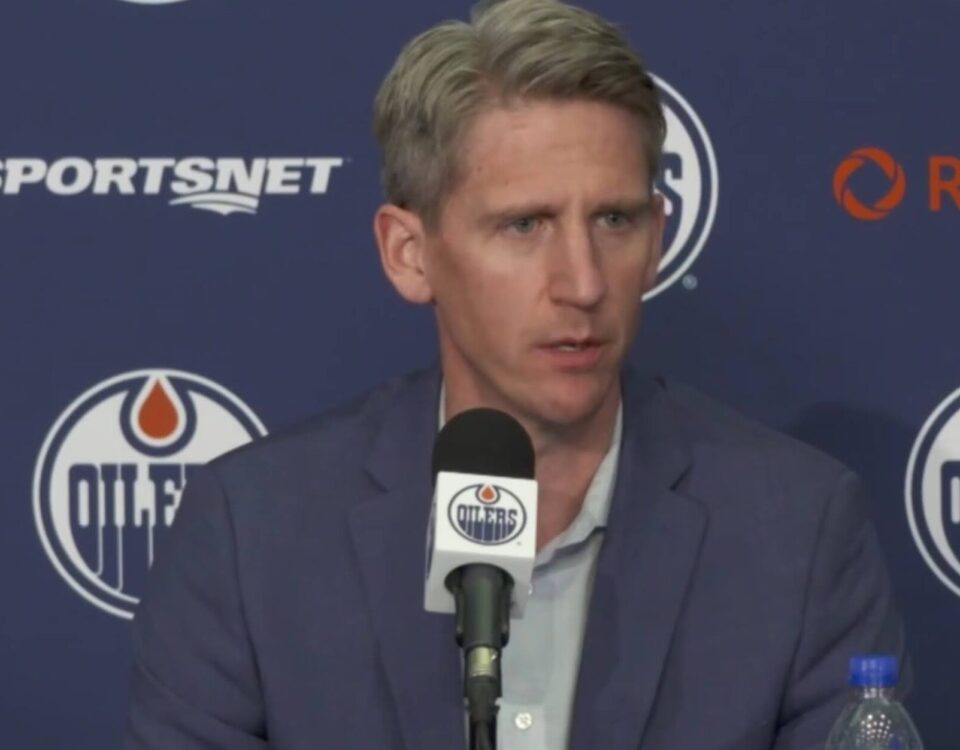
The Legitimacy of the Oilers Trading for Jakob Chychrun
January 9, 2023
Call Outs, Standouts, and Shout Outs: Kings Beat Oilers 6-3
January 10, 2023Ryan Nugent-Hopkins continues to be a significant power-play performer

VANCOUVER, BC - Edmonton Oilers center Ryan Nugent-Hopkins (93) looks up ice during an NHL preseason game(Photo by Derek Cain/Icon Sportswire)
January 9, 2023 by Josh Boulton
Ryan Nugent-Hopkins has been an unsung hero of the Edmonton Oilers in 2022-23. Now in his 12th NHL season, Nugent-Hopkins is establishing himself as the best third line centre in the league who can drive his own line
While he’s been a relatively consistent player throughout his career, his time in the NHL can likely be divided into two distinct eras: pre-and-post-2018. Nugent-Hopkins is a career 0.75 points-per-game player. For seven of his first 11 seasons he stayed within 0.09 of that average, and in one of the other four years, he was 0.15 higher.
The largest deviation came in 2016-17, when he scored just 42 points in 82 games for a points-per-game of just 0.51. Other than that year, he’s been money in the bank, and he just keeps getting better. Between 2011-12 and
2017-18, his points-per-game average was 0.68. Since then, he’s been at 0.86, and he’s currently having his best individual season by far in terms of point production. Through the first 40 games this season, Nugent-Hopkins is averaging 1.18 points-per-game.
From his early days in the league, Nugent-Hopkins has been known specifically as a powerplay specialist. Despite this title, I don’t think people really appreciate exactly what he does and how important he is to the success of the more obvious choices for power-play producers around him. His critics will suggest he’s riding some of those coattails by padding his stats with excessive amounts of the “dreaded secondary assist”.
As far as back 2013, Jonathan Willis wrote an article for the Edmonton Journal showing secondary assists shouldn’t be so undervalued and leaving the idea in the air, perhaps more importantly, that primary assists shouldn’t be so overvalued in comparison. He used Nugent-Hopkins as his base subject.
Related: Call Outs, Standouts, and Shout Outs: Kraken Beat the Oilers 5-2
10 seasons later, the stigma still remains, so I used data gathered from both Hockey Reference and Icy
Data to figure out if there’s any truth to the reputation of Nugent-Hopkins as a secondary assist collector
and, if so, should that reflect negatively on his status as an elite playmaker, particularly on the power-play?
RNH has 357 career NHL assists. 162 of them are secondary assists, or 45.3 percent. In eight individual seasons out of 12, his secondary assists accounted for less than 50 percent of his total assists for those same years, which means only four times his secondary assists accounted for a higher percentage of his overall helpers for the same individual season. Secondary assists account for less than 30 percent of his total career points.

To see how this compares to the rest of the league, I looked at who’s secondary assists made up the highest percentage of their total points for each individual season. To shrink the pool even further, I only included those who had at least the same number of points as Nugent-Hopkins during any given season. You’d think he’d lead that category by a landslide the way people talk about him, but in reality among peers of similar or higher point totals he only cracked the top 20 five times.
One of those years (2019-20) he was exactly 20th among players with 60 points or more that season, with 27 percent of his total points being secondary assists. Connor McDavid ranked 23rd that same year at 26 percent. Some might also think the years he had his highest percentage of points as secondary assists would be all be the seasons he’s played with both McDavid and Draisaitl since they’re the ones supposedly jacking up his secondary assists via the power-play.
However, again, in reality the other times he ranked among the NHL’s top 20 were in three of Nugent-Hopkins’ first four seasons, before McDavid was even drafted. In fact, during McDavid’s first three seasons in the NHL, in terms of percentage of points made up by secondary assists among his peers, Nugent-Hopkins had by far his lowest rankings, not even cracking the top 50 in any of them.
Based on what I’ve seen, Nugent-Hopkins might trend to being on the higher end of the overall spectrum in terms of general secondary assists, but not outrageously so compared to other players who achieve similar or higher point totals. Now, what about on the power play specifically? Could it still be true he jacks up most of his secondary assists with the man advantage? Here’s what the stats tell us.
Through his first seven NHL seasons, Nugent-Hopkins tallied 192 total assists in all situations. Just 33 of those came on the power-play. For seven whole seasons, Nugent-Hopkins averaged just 4.7 secondary power play assists. That’s hardly
earth shattering. Comparatively, he had 39 primary power-play assists over that same span. He only had more secondary assists than primary assists in two of those years.
In fairness, since 2018-19, things have looked different. Nugent-Hopkins accumulated an additional 165 over the last five seasons. 49 of them have come as secondary power-play assists, for an average of 9.8 per year. That’s more than double his output on average from the seven years before before. Contrast that with 36 primary power-play assists, averaging 7.2 primary power play assists per year since 2018-19.
It’s an increase to be sure, but not as dramatic as we see in his secondary assists. Having said that, these averages are swayed in large part because in 2018-19 he had a career-high 14 secondary power-play assists and only four primary ones. In 2019-20 he had the same number of primary assists as secondary assists on the powerplay, and in 2021-22 he actually had more. Since the inflated 2018-19 season, Nugent-Hopkins has averaged a much more even 8.0 primary power play assists per season compared to 8.75 secondary ones.
Yes, over the last five years he’s seen an uptick in both average points-per-season and average secondary power-play assists. But, again, there’s nothing to statistically suggest Nugent-Hopkins is a poster child for secondary assist robbers the world over.
Even at that, suppose you interpret the data differently than I do and he is racking up secondary power-play points more than anyone else. Would that be so terrible? The theory is too many secondary assists means his numbers are inappropriately inflated because he dishes off to others and they do the “real” work and score. That’s probably unfairly oversimplifying it in general for any player, and it’s especially flat out wrong in the case of Nugent-Hopkins.
You don’t get in on that many points just by being that lucky for that long. There’s a reason the puck gets onto his stick as often as it does. It’s the same reason he gets to play on what is currently statistically the most efficient power play in recorded NHL history. At the time of this writing, the Edmonton Oilers power play sits number one of all-time, operating at an over 32% success rate. That’s not a typo.
Like I said, Nugent-Hopkins has developed into a power-play specialist, and is as big a part of that success as anyone else. It’s literally what he’s supposed to do. Between 2011-12 and 2017-18, Nugent-Hopkins scored an average of 31 percent of his seasonal points while on the power-play. It’s true that from 2018-19, that skyrocketed to an average of 41%.
In fact, in two of the last three seasons, over 50 percent of his points have come with a man advantage. So yes, he does get a lot more points on the power-play. But there’s another interesting trend that goes along with that. In any season over his entire career where Nugent-Hopkins got less than 35 percent of his total season points on the power-play, the Oilers as whole with the man advantage averaged a less than 20 percent success rate, and vice versa. In Leon Draisaitl’s rookie season of 2014-15, the Oilers power-play operated at a dismal 18 percent efficency.

The McDavid era also began poorly. Between 2015-16 and 2017-18, The power-play success rates were 18, 23 and percent, respectively. Since 2018-19 to present day, the Oilers first power play unit has been almost unstoppable in attaining success rates per season of 21, 30, 28 and 26 percent, and now the aforementioned 32 percent clip. Studying the relationship between power-play points per player per season and overall team power-play percentage in the first three years of the McDavid era, McDavid and Draisaitl had combined 27, 54, and 33 powerplay points, respectively. Since then, they have each been contributing an average of over 35 power-play points per season.
The overall success rate of the team has obviously gone up accordingly. But let’s not discount the contributions of Nugent-Hopkins to that equation either. Between 2015-16 and 2017-18 he contributed 11, 10, and nine power-play points per season respectively. Since then, he’s personally tallied more than 23 power-play points per year on average. I ask, why is it so obvious to assume the increase in PPP per season for both McDavid and Draisaitl are any more legit or earned than the PPP per season increase of Nugent-Hopkins?
All one has to do is physically watch the Oilers powerplay to see how much of the play goes through Nugent-Hopkins before anywhere else. By no stretch of the imagination am I saying McDavid or Draisaitl would be nothing without Nugent-Hopkins.
It’s not fair to diminish a player’s contributions solely based on how much of it statistically shows up as secondary assists, and it’s not even remotely fair to devalue what Nugent-Hopkins has brought consistently to the table his entire career simply because he has the advantage of playing with two of the best players in the world. Nugent-Hopkins is, and will continue to be, an important player for the Oilers for years to come.


1 Comment
[…] Ryan Nugent-Hopkins continues to be a significant power-play performerWhen Kane does return the Oilers will be set to go into the stretch drive and hunt down a playoff […]